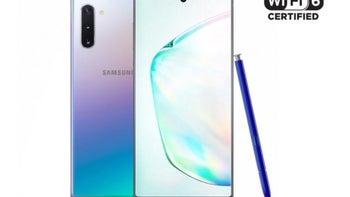Samsung Galaxy Note 10 phones first to be certified for Wi-Fi 6

The Wi-Fi Alliance is the organization that sets standards for the Wi-Fi industry and also certifies Wi-Fi enabled devices, like smartphones for example. Nearly a year ago, the Alliance decided to simplify how it will name future generations of Wi-Fi. For example, the latest generation of wireless local area networking is now known as Wi-Fi 6 instead of Wi-Fi 802.11ax. The previous two generations have been retroactively changed to Wi-Fi 5 (802.11ac technology) and Wi-Fi 4 (802.11n technology). The new naming convention makes it easier for consumers to understand that Wi-Fi 6 is an improvement over Wi-Fi 5.
Samsung announced on Monday that the Galaxy Note 10 and Galaxy Note 10+ phones are the first to receive certification from the Wi-Fi Alliance for Wi-Fi 6. The technology works on the 2.4GHz and 5GHz bands allowing for greater capacity. The manufacturer notes that Wi-Fi 6 will allow folks to simultaneously stream HD entertainment, manage smart appliances in the home, and support various Wi-Fi 6 enabled devices. The latest generation of Wi-Fi will also improve connectivity in high-population areas and will enhance health-care monitoring and e-learning.
"Wi-Fi CERTIFIED 6 is ushering in a new era of Wi-Fi, building on Wi-Fi’s core characteristics to provide better performance in every environment for users, greater network capacity for service providers to improve coverage for their customers, and new opportunities for advanced applications. Wi-Fi CERTIFIED 6 will deliver improvements in connectivity, including in high-density locations and IoT environments."-Edgar Figueroa, president, and CEO, Wi-Fi Alliance
"Wi-Fi CERTIFIED 6 is ushering in a new era of Wi-Fi, building on Wi-Fi’s core characteristics to provide better performance in every environment for users, greater network capacity for service providers to improve coverage for their customers, and new opportunities for advanced applications. Wi-Fi CERTIFIED 6 will deliver improvements in connectivity, including in high-density locations and IoT environments."-Edgar Figueroa, president, and CEO, Wi-Fi Alliance
Capacity improvements in Wi-Fi 6 will keep data speeds from declining at home and in the ballpark
Wi-Fi 6 transfers data 30% faster than Wi-Fi 5 according to CNET, but you'll need a Wi-Fi 6 router and a device that supports the new generation. And that officially includes the Galaxy Note 10 series. While the Wi-Fi Alliance has yet to certify the Apple iPhone 11, iPhone 11 Pro and iPhone 11 Pro Max, the trio does support Wi-Fi 6; it is just a matter of Apple and the Alliance going through the certification process.

The 2019 Apple iPhone models all support Wi-Fi 6
If you wonder why Wi-Fi 6 is necessary when the previous generation was sufficient, consider that more and more products can be connected to the internet via Wi-Fi. Inside your home, you might have a number of devices that seek part of your Wi-Fi signal including a smart TV, smart appliances, refrigerators and more. With the expanded capacity available with Wi-Fi 6, you don't have to worry so much about your Wi-Fi data speeds dropping off as more and more devices are connected to your router.
Unless you pick up a router running on Wi-Fi 6, even if you own a phone that supports the new Wi-Fi generation you probably won't experience it until you're hanging out at an airport or stadium. You can imagine what happens to data speeds when a large number of fans at Yankee Stadium are connected to Wi-Fi at the same time; it's as though every fan is trying to exit the stadium all at once. So you should see upgrades to the Wi-Fi systems found inside airports, malls, stadiums, and even smaller arenas over the next year. And newer flagship handsets released from this point forward should be able to support Wi-Fi 6. Hear that Google?










Things that are NOT allowed: